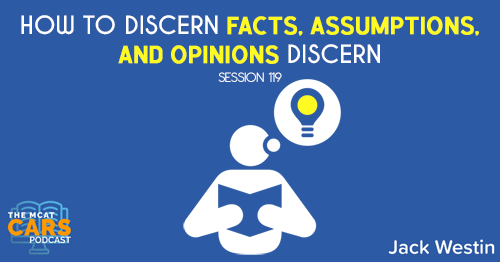Apple Podcasts | Google Podcasts
Session 87
Which is more important, a group or aggregation of things animals, people, or things working together in unison – or the outlier of that group? Today is an interesting passage where predicting the direction the author is going will help you understand things much better.
For more help on your CARS prep, go to JackWestin.com and check out his free daily CARS passages.
Listen to this podcast episode with the player above, or keep reading for the highlights and takeaway points.
[03:29] Why Many Students Fear CARS
When students see a passage on physics, you’re comfortable with whatever is being asked. You’re not going to panic even though there might be a new term there.
'Premeds are not trained to read for CARS passages. They're trained to read a textbook and memorize it. They're not trained to think about whether an opinion is good or bad.'Click To TweetThe issue is that many students have never taken a course on rhetoric that comes up on CARS. They’re not necessarily oriented towards reading. They’re more oriented towards science and math. And for that reason, it becomes problematic.
Therefore, you have to read every day. Don’t tell yourself you’re bad at it. Whether you’re ESL or English is your third language, just work on it. You might be bad at reading today. But that doesn’t mean you can’t be a great reader tomorrow, or next week or next month.
If you’re not mature, if you’re not patient, if you’re not realistic, you will not do well on CARS. And that can give some indication of how well you’re going to adapt to medical school because you will be given hundreds of more tests in the future.
Because there aren’t that many courses that really focus on CARS, what Jack Westin offers is extremely valuable. They can help you change the way you read and the way you answer questions. They do it for the ESL or the science-oriented student in mind. Again, check out Jack Westin’s trial session to see how he breaks things down, and it might give you some information or some tool that you may not have had before.
“There's just so much information in med school. You have to find trends. You have to find patterns and use that to answer questions or to solve problems.”Click To TweetLink to the article:
https://www.quantamagazine.org/out-of-sync-loners-may-secretly-protect-orderly-swarms-20200521/
Dense clouds of starlings dip and soar, congregating in undulating curtains that darken the sky; hundreds of thousands of wildebeests thunder together across the plains of Africa in a coordinated, seemingly never-ending migratory loop; fireflies blink in unison; entire forests of bamboo blossom at once. Scientists have studied these mesmerizing feats of synchronization for decades, trying to tease apart the factors that enable such cooperation and complexity.
Yet there are always individuals that don’t participate in the collective behavior — the odd bird or insect or mammal that remains just a little out of sync with the rest; the stray cell or bacterium that seems to have missed some call to arms. Researchers usually pay them little heed, dismissing them as insignificant outliers.
But a handful of scientists have started to suspect otherwise. Their hunch is that these individuals are signs of something deeper, a broader evolutionary strategy at work. Now, new research validating that hypothesis has opened up a very different way of thinking about the study of collective behavior.
Early clues emerged after Corina Tarnita, a mathematical biologist at Princeton University, and her colleagues turned their attention to the cellular slime mold Dictyostelium discoideum. Typically, it lives as a collection of solitary amoebas, with each cell eating and dividing on its own. But when threatened with starvation, up to a million of those cells can coalesce into a mushroom-like tower. Around 20% of them create a stalk, sacrificing themselves so that the rest can move to the top of the structure and form spores, which can last for months without food. Ultimately, water and wind disperse those spores to new and potentially more nutrient-rich environments.
Scientists have used slime molds to experimentally investigate the emergence and maintenance of social behavior, identifying mechanisms that ensure cooperation among the amoebas. But they’ve always focused on the aggregated cells. Tarnita and her team wanted to investigate whether the cells that stayed behind — the “loners,” as they called them — also played an important role.
[08:14] Paragraph 1, Sentence 1
Dense clouds of starlings dip and soar, congregating in undulating curtains that darken the sky; hundreds of thousands of wildebeests thunder together across the plains of Africa in a coordinated, seemingly never-ending migratory loop; fireflies blink in unison; entire forests of bamboo blossom at once.
Jack says:
We’re having this picture here of animals and nature. Seems like there’s lots of movement going on in unison. They blink in unison. So they’re coordinated. That’s the key. And that’s the beautiful part about nature.
'Visualizing is a really important way to read these passages. Try to see what the author sees. Try to interpret it the way the author interprets it.'Click To Tweet[09:52] Paragraph 1, Sentence 2
Scientists have studied these mesmerizing feats of synchronization for decades, trying to tease apart the factors that enable such cooperation and complexity.
Jack says:
The scientists have been trying to figure out how all of this happens. The author is making this a big point. The author cares about this. Why else would they bring it up?
[10:26] Paragraph 2, Sentence 1
Yet there are always individuals that don’t participate in the collective behavior — the odd bird or insect or mammal that remains just a little out of sync with the rest; the stray cell or bacterium that seems to have missed some call to arms.
Jack says:
The author just painted a picture of all of these things working together and there’s always an odd bird or insect out. So the direction just completely shifted. The author seems to be more focused on the odd one out.
[11:06] Paragraph 2, Sentence 2
Researchers usually pay them little heed, dismissing them as insignificant outliers.
Jack says:
The author here is saying that researchers usually just ignore them. That probably is trying to allude to how maybe important they are in the future. They haven’t specified that. But why else would they bring it up? Why else would the author focus on it?
As you read, assume that maybe they’re going to go into this and it’s okay to predict the future. You don’t know the exact direction until you read it. You don’t have to be blind going into it and misread it or not pay attention anymore. If the author goes in a different direction, and you went a different direction, it just keeps you more engaged.
'Predict what you think is going to happen, but keep an open mind.'Click To TweetIn psychology, they call this a schema. If you see something, you can predict what’s coming up. So it helps you with your memory. It helps you with your understanding.
To some extent, this is necessary. When you’re reading, you need to predict, or else you’re going to get lost. But that prediction isn’t a blind prediction. It’s more like thinking where it’s happening, what’s happening, and where we’re going. But then be open to change if you notice that it’s changing into a totally different direction. Prediction is good, but not a blind prediction.
[13:05] Paragraph 3, Sentence 1
But a handful of scientists have started to suspect otherwise.
Jack says:
By “otherwise,” meaning that they are not insignificant outliers. So some are looking at them as potentially more significant.
[13:22] Paragraph 3, Sentence 2
Their hunch is that these individuals are signs of something deeper, a broader evolutionary strategy at work.
Jack says:
So the scientists are trying to figure out what’s going on and potentially, from an evolutionary standpoint, that they’re important.
[13:40] Paragraph 3, Sentence 3
Now, new research validating that hypothesis has opened up a very different way of thinking about the study of collective behavior.
Jack says:
The author here is talking about this research on these outliers and how it’s making us think about how we thought about the collective earlier.
[14:12] Paragraph 4, Sentence 1
Early clues emerged after Corina Tarnita, a mathematical biologist at Princeton University, and her colleagues turned their attention to the cellular slime mold Dictyostelium discoideum.
Jack says:
We’re given a name here who’s an ecologist and theoretical biologist at Princeton and an overachiever. They’re looking at a cellular slime mold. And it looks like they potentially are the ones that started thinking about this.
[14:53] Paragraph 4, Sentence 2
Typically, it lives as a collection of solitary amoebas, with each cell eating and dividing on its own.
Jack says:
The author is describing what the slime mold does with each cell eating and dividing on its own. So it sounds like they’re all separate individuals at this point.
[15:12] Paragraph 4, Sentence 3
But when threatened with starvation, up to a million of those cells can coalesce into a mushroom-like tower.
Jack says:
So the slime mold is composted of all the individuals, but if there’s an issue then they go into this unison or collection of which was described in that first paragraph.
[15:48] Paragraph 4, Sentence 4
Around 20% of them create a stalk, sacrificing themselves so that the rest can move to the top of the structure and form spores, which can last for months without food.
Jack says:
Talking about the collective, there’s some that will sacrifice themselves and what the rest do. So just know here that they’re discussing unison and maybe this 20% will be important. But we’ll have to keep reading.
[16:20] Paragraph 4, Sentence 5
Ultimately, water and wind disperse those spores to new and potentially more nutrient-rich environments.
Jack says:
Just more details on what happens next. They just get to move around to where maybe more food is.
[16:43] Paragraph 5, Sentence 1
Scientists have used slime molds to experimentally investigate the emergence and maintenance of social behavior, identifying mechanisms that ensure cooperation among the amoebas.
Jack says:
Just more study presented of the slime molds and what they’re doing on a social standpoint, working together.
[17:06] Paragraph 5, Sentence 2
But they’ve always focused on the aggregated cells.
Jack says:
It means they’re focusing on the collective. And going back to the beginning – it’s the dense clouds of starlings and the wildebeest running together. So the scientists have always focused on all of the cells together.
[17:24] Paragraph 5, Sentence 3
Tarnita and her team wanted to investigate whether the cells that stayed behind — the “loners,” as they called them — also played an important role.
Jack says:
This goes back to the researcher at Princeton again who’s looking less at the collective and more at the ones who stay behind, which they call the loners or outliers, and why.
[18:07] Main Idea
The key point of this article is that the loner is more important than the unison or aggregate. As to why that is, this passage is actually taken from a longer article.
But we do want to just focus on the key points that help us understand the direction the author’s going in.
Even though in the beginning, they discussed the unison and cooperation, the author is trying to pull us into another direction. And if you can predict that, the rest of the article will be very easy to read and you’ll understand it a lot better.
Links:
Link to the article:
https://www.quantamagazine.org/out-of-sync-loners-may-secretly-protect-orderly-swarms-20200521/
SEARCH SITE
SEARCH SITE
LISTEN FOR FREE












